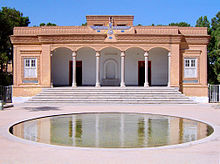Fire temple



A fire temple ( Persian آتشکده Āteschkadeh ; in India Agiary ) is the place of worship in Zoroastrianism . As a building and with its related sacred acts, thetemple is a place ofencounter between man and the divine.
A fire temple usually consists of a hall with various small rooms, the most sacred of which houses the sacred fire. Here priests and believers perform rituals and sing chants. The important role that fire has always played in Iranian religions has changed over time. In today's Mazdaism or Zoroastrianism, fire is considered a cleansing power, and is identified with truth ( Asha : law, order) and associated with the Amesha Spenta Asha Vahishta . There are three degrees of fire: Atash Dadgah, Atash Adaran and Atash Behram, the latter being the most sacred.
history
The first fire altars may have been built by the Achaemenids , but they are mostly uncovered sanctuaries on artificial elevations. It was assumed that the Spirit of God ( Ahura Mazda ) could not be locked into a room. Examples were found at Pontos (according to Herodotus ) and in Cappadocia (according to Strabo ).
Probably the oldest roofed fire temple can be found at Kuh-e Chwadscha from the Seleucid or early Parthian period , where the fire was probably housed in an innermost sanctuary. Large fire temples such as the Atur Gushnasp on the Tacht-e Suleiman are known mainly from the Sassanid period . After the Islamic conquest of Persia, most of the fire temples were destroyed or turned into mosques over time . In more recent times, several fire temples have also been reconstructed in Iran, as Zoroastrianism is tolerated there today. In 1978 a modern fire temple was built in Isfahan .
The center of Iranian Zoroastrianism today is Yazd . A fire temple was built there in 1934 on a plot of land owned by Indian Parsees, the fire of which comes from Ardakan and is said not to have been extinguished since 470 AD. In the surrounding mountains there are several Zoroastrian pilgrimage sites (Seti Pir; from pir "old, wise man") . The holy stalactite cave Pir-e Sabz located in a hill (also called Tschak Tschak, also called Tschak -e Ardakān to describe the falling drops of water onomatopoeic ) is located about 55 kilometers northeast of Yazd near the city of Ardakan.
The seven famous fire temples of antiquity
- Azer More ( Persian آذر مهر) (instead of Azar also Atash ).
- Azer Bahram ( Persian آذر بهرام)
- Azer Nusch ( Persian آذر نوش), Tacht-e Rostam (Balch) or Nusch Azar (Nūš Āzar) or Nau Bahar and Tachte i Soleiman near Tabriz
- Azer Bahrin ( Persian آذر برین)
- Azer Aien ( Persian آذر آیین)
- Azer Chorin ( Persian آذر خرداد), Concerning the sun , Azar Chordad or Naqsch-e Rostam near Shiraz, rarely also Tachte Rostam ( table of Rostam ), Naqsch means pattern
- Azar Showers ( Persian آذر زردشت)
With the seven above The so-called fire temples are extinguished fireplaces, the memory of which is particularly fostered by today's Zoroastrians. Under the Sassanids there were also three great “empire fires” that were of particular importance to the kings. Today there are still some fire temples in Iran whose fires, according to Zoroastrian tradition, have never been extinguished. B. in Yazd.
The above-mentioned fire places were related to seven highest spirits in the realm of light or fire and to six zodiac signs or months:
- Barzisavah (fire in honor of Ahura Mazda )
- Vohufrayana (fire in honor of humans and animals)
- Urvazishta (fire in honor of plants)
- Vazischta Feuer von Donner or Azarrachsch (lightning fire, Rachsch is the name of the horse from Rostam)
- Spandscharusch (giant fire)
- Nava Vihara = Nau Bahar (fire in the New Spring before New Balch)
- Spanishta = Spanta Holy fire, fire of the Zoroaster
The six constellations are:
- Vohu manah, Bahman: Good Thought (Bahman = Aquarius)
- Aša vahišta, Ordibehešt: best truthfulness / righteousness (Ordibehešt = bull)
- Xšathra vairya, Šahrivar: rule (Šahrivar = virgin)
- Spenta armaiti, Esfand: holy thought, holy humility / piety (Esfand = fish )
- Haurvatat, Ḫordad: maturity, wholeness (Hordad or Chordad = twins well-being)
- Ameretat, Amordad: immortality (Amordad or Mordad = lion )
See also
- Surch Kotal , Kushan fire temple in northern Afghanistan
- Ateschgah , fire temple in Baku
literature
- Sina Vodjani and Gabriele von Kröcher: Zarathustra. Membrane International, Hamburg 2006, ISBN 978-3-86562-739-1 , pp. 16 f., 26 f. and 46-69.
- Friedrich Schrader : At the fire temple. In: Magdeburgische Zeitung, Mondaysblatt (scientific supplement) No. 19, 1908.
Web links
- Fire temple . In: Ehsan Yarshater (Ed.): Encyclopædia Iranica (English, including references)
- Fire Temples. History of Fire Temples in India . sympatico.ca


